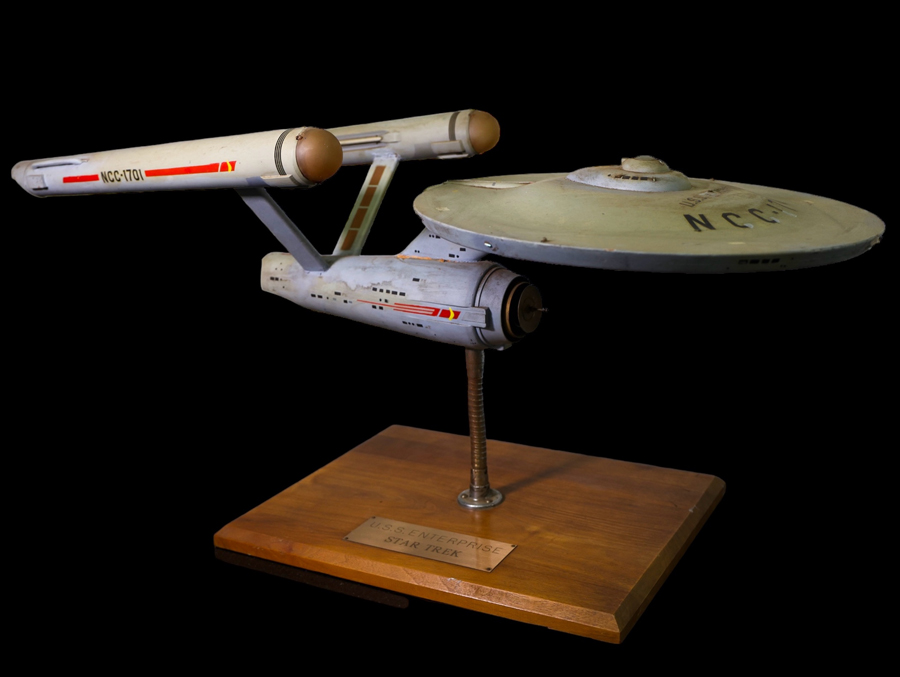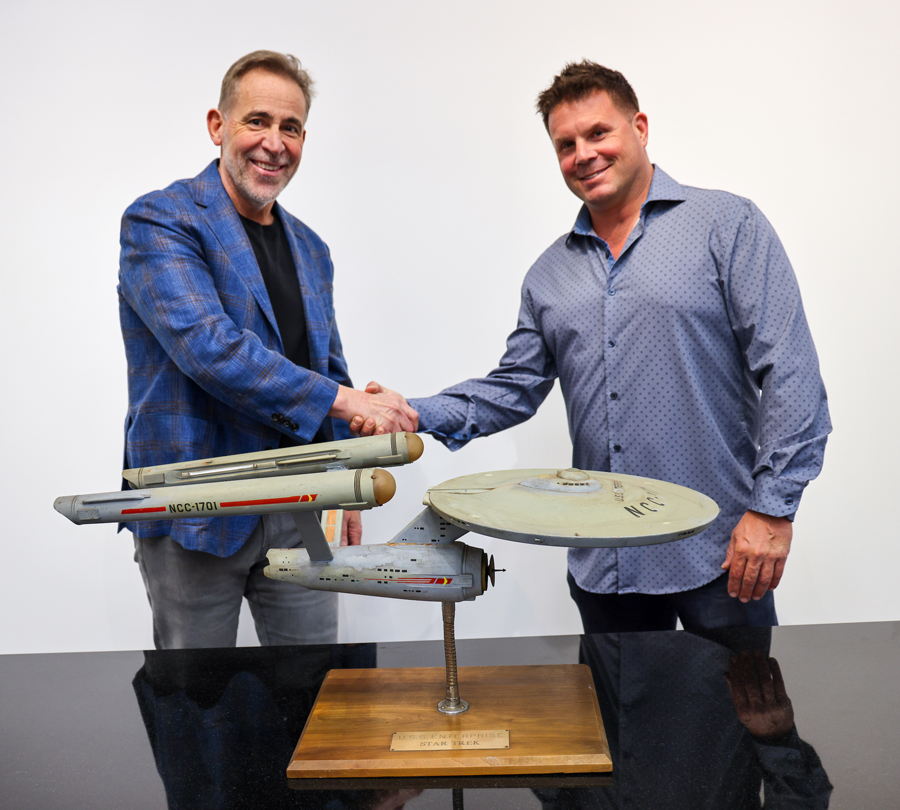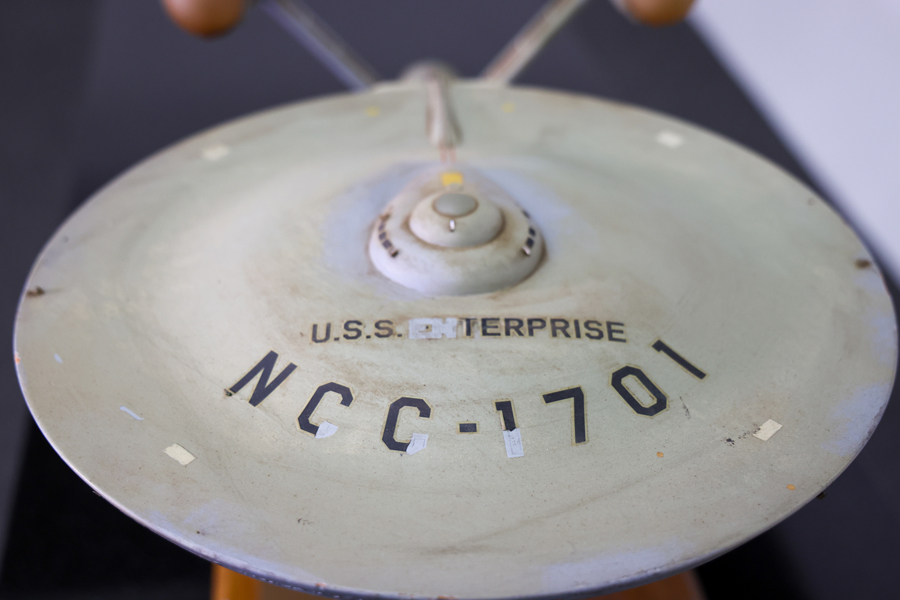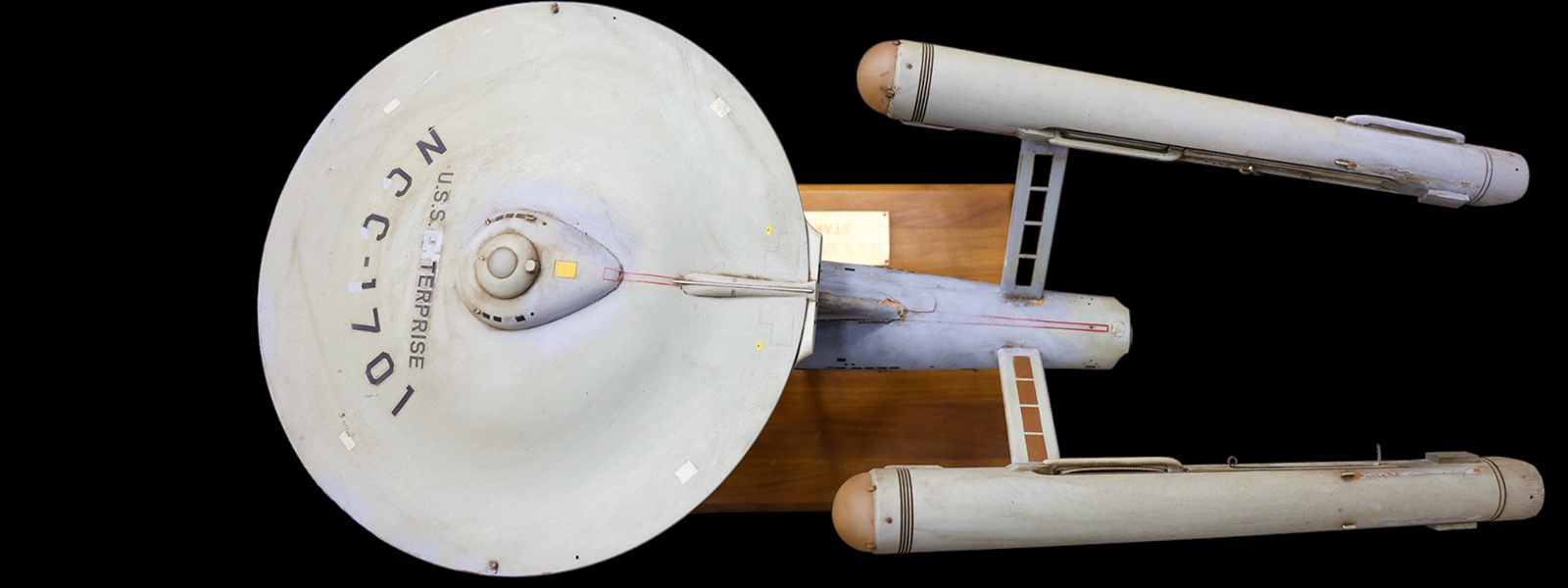THE RECENTLY DISCOVERED PROTOTYPE WAS USED IN THE SHOW’S OPENING CREDITS AND PILOT EPISODE ‘THE CAGE’
By Robert Wilonsky • Photos by Josh David Jordan
The original USS Enterprise has completed its voyage home.
On April 13, Heritage Auctions Executive Vice President Joe Maddalena returned the 3-foot-long model of the Federation’s flagship, used in the original Star Trek series’ opening credits, to Eugene “Rod” Roddenberry Jr., son of Star Trek creator Gene Roddenberry and caretaker of his father’s legacy. The handoff occurred at Heritage Auctions’ Beverly Hills location, where the Enterprise was stored for safekeeping.
Enlarge

This Enterprise was also used in Star Trek’s pilot episode, “The Cage,” and became the prototype for the 11-foot-long starship famously on display at the Smithsonian’s National Air and Space Museum. It’s believed the ship was lost in the 1970s when Gene loaned it to the makers of Star Trek: The Motion Picture.
Last fall, an individual discovered the long-lost model and brought it to Heritage for authentication. Heritage then reached out to Roddenberry Jr. to coordinate the return of the Enterprise.
“Once our team of experts concluded it was the real thing, we contacted Rod because we wanted to get the model back to where it belonged,” Maddalena says. “We’re thrilled the Enterprise is finally in dry dock.”
Enlarge

“After five decades, I’m thrilled that someone happened upon this historic model of the USS Enterprise. I remember how it used to adorn my dad’s desk,” says Rod Roddenberry, CEO of Roddenberry Entertainment. “I am tremendously grateful to Heritage Auctions for facilitating the return of this iconic piece of Star Trek history to my family. I can’t wait to figure out how we are going to share it with my extended family, Star Trek fans around the world. We look forward to making that announcement.”
The USS Enterprise was famously designed by Star Trek’s art director, Walter “Matt” Jefferies, the namesake for the Jefferies tubes referenced in numerous episodes throughout the franchise’s storied history.
In the 1968 book The Making of Star Trek, co-written by Stephen Whitefield and Gene Roddenberry, Jefferies said that the Enterprise design “was arrived at by a process of elimination,” based partly on designs he’d seen at NASA, Douglas Aircraft and other aerospace engineering outfits.
Enlarge

“We didn’t want the Enterprise to look like something currently planned for our space program,” Jefferies said in the book. “We knew that by the time the show got on the air, this type of thing would be old hat. We had to go further than even the most advanced space scientists were thinking.” Jefferies said he aimed only to create something “instantly recognizable.”
Jefferies said Roddenberry wanted the Enterprise to be “large enough to carry a crew of several hundred people.” According to Jeffries, Roddenberry had very specific instructions: “No flames, no fins, no rockets – and make it look like it’s got power.” The series’ creator wanted everything to be “believable,” which forced Jefferies to base his design “on fairly solid scientific concepts, projected into the future.” They sketched out myriad possibilities and filled walls with conceptual renderings – which Roddenberry didn’t like except for “a piece of this one or a small part of that one,” Jefferies said. Over time, everyone who had a hand in the production, even the sales department and a representative from the Rand Corporation, got involved. Meanwhile, the studio wondered what was taking so long.
Enlarge

“My feeling was that if you didn’t believe in the spaceship,” Roddenberry wrote in The Making of Star Trek, “if you didn’t believe you were in a vehicle traveling through space, a vehicle that made sense, whose layout and design made sense, then you wouldn’t believe in the series.”
That sentiment continues to be integral to Roddenberry Entertainment, which recently launched the video podcast Does It Fly? based on Gene’s original desire to make the USS Enterprise scientifically sound. The podcast, hosted by scientist Hakeem Oluseyi and pop culture aficionado Tamara Krinsky, discusses and debates the real-life viability of today’s favorite entertainment conceits.
Once Roddenberry and Jefferies finally settled on the basic design for the ship christened NCC-1701, a prototype was made using balsa wood and cardboard. Custom-scale model-maker Richard Datin Jr. fabricated a 33-inch wood, hand-painted model used for The Original Series’ opening credits and in the pilot episode “The Cage” – the model that has now been returned to the Roddenberry family so that it may live long and prosper.
 ROBERT WILONSKY is a staff writer at Intelligent Collector.
ROBERT WILONSKY is a staff writer at Intelligent Collector.

